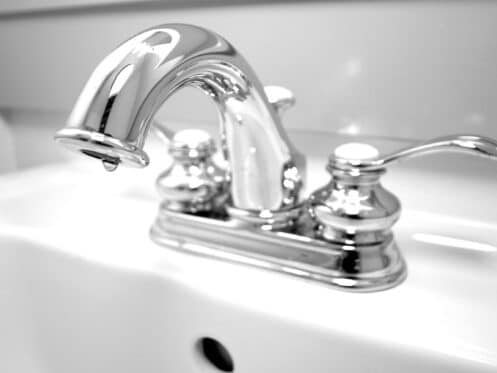Life is definitely more enjoyable when you are not constantly dealing with the annoyance of leaky faucets. There’s something about having everything in your home work smoothly that just makes everything feel right. Plus, you don’t have to worry about wasting water, dealing with water damage or the constant drip-drip-drip sound that can drive anyone crazy. It is amazing how such a small thing as fixing a leaky faucet can make such a big difference in your overall quality of life.
Signs of a Leaky Faucet
A leaky faucet might seem like a minor inconvenience, but it can lead to significant water waste and even structural damage if left unaddressed. One of the most common signs of a leaky faucet is the persistent sound of dripping water, which can be both annoying and indicative of a larger problem. Another telltale sign is water pooling around the base of the faucet or on surrounding surfaces. You may also notice a gradual increase in your water bill without any apparent increase in water use. If you suspect a leaky faucet, it’s essential to address it promptly to prevent further damage and conserve water.
Causes of Leaky Faucets
While there are many potential causes of a dripping faucet, worn or broken internal components are usually to blame. Regular use can wear out the seals, O-rings and washers within the faucet, which can cause leaks as time goes on. Mineral accumulation is another typical reason, especially in places with hard water. As time passes, mineral deposits will build up on the inner workings of the faucet, rendering them inoperable and letting water leak out. And since the parts of the faucet are already under enough stress from the high water pressure, leaks are inevitable. Finally, low-quality materials or sloppy installation might lead to dripping faucets.
What to Do When You Discover a Leak
While it might be tempting to tackle a leaky faucet repair on your own, enlisting the help of a professional plumber is often the best course of action. However, there are several important things you should do while waiting for the plumber to arrive.
Turn Off the Water Supply
When dealing with a leaky faucet, one of the first and most important steps is to shut off the water supply. This helps prevent further water damage and allows you to assess the situation more effectively. It also lets the plumber work on the faucet without water spraying everywhere, making the repair process safer and more manageable.
You can usually find the main water supply valve near the water meter or where the main water line enters your home. In some homes, you may find it in the basement, crawl space or utility closet.
Collect Dripping Water
Collecting the dripping water will also help prevent water damage and waste. One simple solution is to place a bowl or basin underneath the faucet to catch the drips. Make sure the container is large enough to hold the dripping water, and check it regularly to prevent overflow.
Another option is to use a rag or towel to soak up the dripping water. Simply place the cloth under the faucet and wring it out periodically to remove the collected water. Alternatively, you can attach a small bucket or container directly to the faucet using a clamp or clip to catch the drips more effectively. These methods can help minimize the mess and make cleanup easier while you wait for the plumber to arrive.
Wipe Away Excess Water
You need to clean up any excess water to prevent slips, falls and water damage. Start by using a clean towel or rag to wipe down the area around the faucet, ensuring that no water pools on the countertop or floor. Pay attention to any moisture that may have seeped into cracks or crevices, as this can lead to mold and mildew growth over time. For hard-to-reach areas, consider using a sponge or mop to absorb excess water and dry the surface thoroughly.
Ventilate the Area
Proper ventilation is crucial when dealing with a leaky faucet to prevent the buildup of mold, mildew and unpleasant odors. Open windows and doors to allow fresh air to circulate throughout the space. This will help dry out any moisture that may have accumulated. If the weather permits, consider using a fan to increase airflow and expedite the drying process.
Besides letting some fresh air in, consider using a dehumidifier to suck up any extra moisture hanging around. This not only helps prevent mold from setting up shop but also makes the whole place feel a lot nicer. Air purifiers can help remove contaminants and odors from the air, improving airflow and indoor air quality.
Identify the Type of Leak
Take a closer look at the faucet to determine where exactly the leak is coming from. Is it trickling out from under the handle, or is it pooling around the base? Next, try turning the faucet on and off to see if the leak changes in intensity. This can give you clues about whether the issue lies in the faucet’s handle, spout or connections underneath.
Pay attention to any sounds the faucet makes when it is turned on or off. Is there a hissing noise or a steady drip? These auditory cues can help you describe the problem more accurately to the plumber, which in turn helps them come prepared with the right tools and parts to fix it efficiently.
Inspect Surrounding Fixtures
Check nearby walls, floors and cabinets for discoloration, warping or moisture accumulation, as these could indicate water seepage. Look under the sink and around the base of the faucet for any visible leaks or drips.
Inspect other nearby fixtures, such as adjacent sinks or showers, to ensure they’re not experiencing similar issues. This can help you determine if you’re dealing with a problem isolated to the specific faucet or one that is part of a larger plumbing issue.
Document the Leak
Documentation is key to conveying the problem accurately to the plumber. Start by taking clear photos or videos of the leak from different angles and distances. This helps provide a visual reference for the plumber, allowing them to assess the severity of the issue before arriving.
Next, jot down any relevant details about the leak, such as when it started, how often it occurs and any changes in its intensity. These notes can help the plumber understand the history of the problem and develop an effective solution.
Keep track of any attempts you’ve made to temporarily fix the leak, such as tightening the faucet handle or applying sealant. This information can help the plumber identify potential underlying issues and avoid repeating unsuccessful repair attempts.
DeWolfe Plumbing, Heating & Cooling is a leading provider of heating, cooling, plumbing and excavation work in West Boylston, MA. If you need help fixing a leaky faucet, contact DeWolfe Plumbing, Heating & Cooling now!


